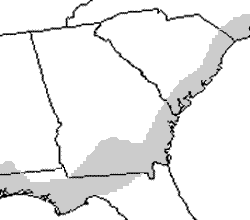Mimic Glass Lizard (Ophisaurus mimicus)


Photos by J.D. Willson unless otherwise noted
Description: 15 – 26 in (38 – 66 cm). Glass lizards are long, slender, legless lizards that superficially resemble snakes. They differ from snakes, though, in that they have moveable eyelids, external ear openings, and inflexible jaws. Although generally smaller than the more common eastern and slender glass lizards, the mimic glass lizard is also brown or yellowish in coloration. This species is best distinguished from other glass lizards by the presence of several dark stripes down each side of the body, above the lateral groove, and a dark dorsal stripe.
Range and Habitat: Mimic glass lizards are found along the coast of South Carolina and in coastal and southern Georgia. Like the slender glass lizard, this species tends to prefer dry habitats and is most common in longleaf pine flatwoods. The distribution and ecology of this species are poorly understood and warrant scientific study.
Habits: Glass lizards forage actively by day in open habitats but are commonly found taking refuge beneath boards and other debris. When seized, glass lizards commonly break off all or part of their tail (which makes up more than half of their total length) which later regrows. With the predator distracted by the wriggling tail, the lizard is free to escape.
Prey: Although the ecology of the mimic glass lizard is poorly understood, this species most likely feeds on insects, spiders, and other invertebrates. Unlike snakes, lizards have rigid jaw bones and thus are unable to eat meals larger than the size of their head.
Reproduction: Although reproduction in this species remains poorly understood it is probably that female mimic glass lizards lay several eggs in early summer and attend the eggs until they hatch.
Abundance: The mimic glass lizard is a recently described species and it is uncertain how widespread or common it is. At present it is thought to be uncommon or rare in most areas.
Notes: Glass lizards earned their name by their propensity to “shatter” by breaking their tail, often in several pieces. The common belief that these pieces can rejoin is a myth, although the tail will slowly regrow over a period of months or years.
